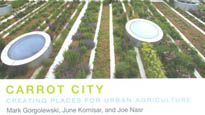It seems to me that the world’s coolest cities have one theme in common: an active and distinct food culture. Eating and cooking can create many a platform for unique public spaces, nightlife, and community endeavours. As of yet though, even the most capable cities can produce only small yields of produce from downtown plots. Bummer. But what if we could use the space available, on top of buildings, in parks, and vacant lots, as regular sites for sprouting?
Three academics from Ryerson asked this question, and made a book about finding the answer. Carrot City: Creating Places for Urban Agriculture offers 40+ examples of what cities across the world would look like as major food producing sites. The projects it shows range from gardens tucked under raised highways to unique home sprouting devices.
Achitecture students at Ryerson were the ones who fueled most of the ideas in the book. “Several students started doing thesis projects looking at the impact of food on the buildings they were designing, so we created a support group which involved myself, (and co-authors) Joe Nasur and June Komisar, and we brought some experts in to give them advice. These projects became some of the best thesis projects we’d seen here at Ryerson,” explains Mark Gorgolewski, co-author and director of Architecture.
From the time the students wrote their theses, Gould Street had become a vegetable garden, harvest parties were going down, and the community food room began looking a little more like Whole Foods. Carrot City was born, and became a travelling exhibit that was showcased in Casa Blanca, Rabat, Morocco, Connecticut, Road Island, New York, Montreal and Toronto.
Carrot City, the book, compiled these ideas with equally innovative projects that already exist around the world. They all rely on sustainable methods and cutting edge design. The range of technologies span from handmade recycled living food boxes (Carrot Common Green Roof, 348 Danforth Ave.) to sophisticated greenhouse weather sensors (The Manhattan School for Children, 154 West 93rd St)
Mark Gorgolewski explains this choice. “Some traditional gardeners feel that there isn’t a need for new technology, and that we just need to get back to growing food in a traditional way. There’s nothing wrong with that, in fact that’s the way that we used to produce much healthier food than we do now. So we tried to present a variety of different approaches.”
City farming is usually associated with grassroots methods and elbow grease, (we tend to think of a gum boot clad farmer hauling bags of dirt up a fire escape, and trowel-ing and trellising her way to a tomato garden), but smart technologies play a really cool part in the book too. And Carrot City shows, rather than new technologies simply replacing older, clunkier ones, agriculture is an area where both low and sophisticated technologies can co-exist together. City sprouting rules!
Snap up this read and get jazzed about sprouting this spring!
~ Kait Fowlie



 Follow Us On Instagram
Follow Us On Instagram
